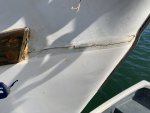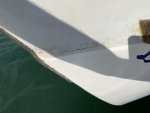Samosun
Member
Hi, I'm considering a boat and on inspection found the cracking in the attached images at the bow on what I assume is the Hull/deck joint.
Current owner says it's been there since he's had the boat.
I'd appreciate peoples opinions on this and what it might take to repair (based on the limited info I have given). I have not yet been below deck as with permission I viewed the boat on its mooring without the owner.
I don't mind doing some grp work, but what is the chance this runs further below the wooden trim? is this likely cosmetic or is this a structural issue. Possible repairs needed?
Any constructive input welcome. Thanks!
Current owner says it's been there since he's had the boat.
I'd appreciate peoples opinions on this and what it might take to repair (based on the limited info I have given). I have not yet been below deck as with permission I viewed the boat on its mooring without the owner.
I don't mind doing some grp work, but what is the chance this runs further below the wooden trim? is this likely cosmetic or is this a structural issue. Possible repairs needed?
Any constructive input welcome. Thanks!






